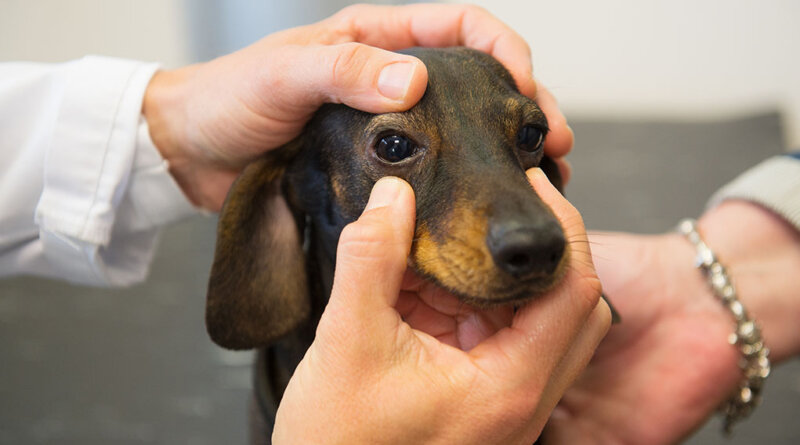Progressive Retinal Atrophy (PRA) In Dogs – Top Dog Tips
Have you noticed that your dog has night blindness? Or are they bumping into objects that they usually don’t? If that’s the case, this might be the doing of Progressive Retinal Atrophy.
If ever you notice that your dog is showing signs of vision loss, it is best advised to contact your vet immediately. PRA is not the only eye disease that can be affecting your pup.
Unfortunately, if your dog suffers from PRA, its vision will slowly worsen over time until they become completely blind.
This article will discuss everything you need to know about PRA in dogs. But before we dive all the way in on PRA, we must first have a basic understanding of the functions of the Retina.
What is the function of the retina?
Before we discuss anything about PRA, let’s first talk about the function of the retina. So what is the Retina? The Retina is a light-sensitive layer of cells at the back of the eye that has cells that sense light called photoreceptors.
For instance, when light enters the eye, it is now focused by the lens onto the retina. This is where the light is converted into electrical signals that are delivered to the brain for processing and understanding.
Moreover, the two main photoreceptor cells of the retina are; rods and cones. In dogs, their eyes have more rods than cones. Rod cells are in control of vision in low light circumstances and for detecting and tracking movement. On the other hand, cone cells are responsible for detecting color and they do not work well in low light.
What Is Progressive Retinal Atrophy?
Now let’s further discuss PRA. This condition can occur in almost any type of dog breed. Progressive Retinal Atrophy is an inherited disease that causes blindness in dogs.
The word Atrophy means the partial or complete wasting of a body part. With PRA, the photoreceptor cells deteriorate over time and will gradually lead to blindness.
Fortunately, for the average pet, blindness is not as important as it would be in a human. Dogs rely more on their sense of smell. Also, they’ll be able to move around the house as long as the furniture and other objects are not moved.
Howevremembermind that cataracts can still develop in the later stages.
Keep in mind that this is a hereditary disease. That’s why it’s important to adopt from a reputable breeder.
A responsible breeder can show you health clearances that the dog’s parents are both free from any genetic health conditions. In this way, you can ensure that your pup can be as healthy as possible.
Types of Progressive Retinal Atrophy
Two main forms of PRA can affect your dog and they are both considered to be hereditary.
Generalized Progressive Retinal Atrophy
Also known as GPRA, Generalized Progressive Retinal Atrophy is the most common type of PRA. GPRA can affect both young and old dogs.
The first form of GPRA is an early-onset GPRA, this is where the rods and cones have not properly developed and that leads to vision problems. It is usually diagnosed in puppies around 2-3 months of age.
On the other hand, vision loss in late-onset GPRA will be slow since the rod and cone cells worsen over time. Late-onset is typically detected in adult dogs that age between 3-9 years old.
Central Progressive Retinal Atrophy
Furthermore, Central Progressive Retinal Atrophy or CPRA is the less common form of PRA. It is also known as retinal pigment epithelial dystrophy (RPED). It is a rare eye condition that causes the pigmented layer of the retina to deteriorate, making dogs difficult to see in low light.
Usually, CPRA is found in older dogs and it does not always lead to complete blindness.
Symptoms of Progressive Retinal Atrophy in Dogs
Progressive Retinal Atrophy is hard to detect in its early stages of development since it is not a painful condition. However, the most noticeable symptoms of progressive retinal atrophy are directly connected to a dog’s capability to see well.
It can take months or years for PRA to completely damage a dog’s eyesight.
Moreover, here are the signs of PRA that you should look into:
- Night Blindness
- Day Blindness
- Bumping into objects, furniture, or walls they usually don’t
- Difficulty in seeing in bright light
- Unable to follow commands
- Hesitance to go down the stairs or jump down steps
- Decreased color of the pigment of the eyes
- Eyes begin to have a cloudy look
- Cataracts form on the retina
Causes of Progressive Retinal Atrophy in Dogs
There’s still no exact cause for PRA since it’s not yet fully understood by vets and researchers. However, progressive retinal atrophy is a hereditary condition.
Typically, it is inherited in an autosomal recessive pattern. This means the dog has inherited the defective gene from both of its parents.
On the other hand, some dog breeds’ causes seem to be a dominant gene. For instance, Old English Mastiffs and Bullmastiffs. This means that a dog only needs to inherit one copy of the defective gene for them to be affected by PRA.
Moreover, that’s why dogs that are suffering from PRA should never be used for breeding.
Dog breeds that are prone to get PRA
On the other hand, some dog breeds, whether they are purebred or mixed, can still be affected by PRA. Below, is a short list of dog breeds that are commonly affected by Progressive Retinal Atrophy.
Diagnosis of Progressive Retinal Atrophy in Dogs
Again, if ever you’ve noticed that your dog is suffering from vision loss, it would be best to contact your vet immediately or your vet can recommend you to a veterinary ophthalmologist for further examination.
Your vet will now perform a thorough eye exam and tests to identify the problem. Some vets use the process of elimination. Since PRA is a progressive eye problem that can take years to damage vision, other acute eye disorders will be considered and ruled out.
Usually, the method used to diagnose any dog eye abnormalities is the electroretinogram (ERG). This test will measure the response of your dog’s retina to light.
Even before dogs start exhibiting overt symptoms, the ERG can detect PRA in them. Fortunately, this test and the elf have no pain for your dog. But it will take some time for them to adjust.
Moreover, in some areas, there may be genetic testing for inherited PRA. This examination could be used to identify disease carriers.
In addition, it is your job as the pet owner to support them and help them adjust to their new lifestyle. For example, start by installing gates to your pool or any kind of property that can harm them.
Treatment for PRA in Dogs
Unfortunately, there is still no effective treatment for PRA. Also, the use of antioxidant supplements or vitamins has not exhibited any impact on the disease. However, some supplements can help relieve stress on the lens cells and delay cataract formation.
The only way to deal with PRA is through prevention. Dogs with PRA, their parents, and other offspring should not be bred anymore.
In breeds susceptible to PRA, annual eye exams with the Australian Canine Eye Scheme (ACES) should be performed.
Living with a Blind Dog
Eventually, a dog suffering from PRA will go blind. Fortunately, PRA is not a painful eye condition.
The most important sense to a dog is smell, hearing, then lastly, sight. Since their vision is the third most important sense to them, most dogs can still do well even when blind.
PRA is not something that happens in a blink of an eye. This condition takes time or develops slowly in most dogs. That’s why they have more time to adjust and memorize their environment or home.
When it comes to living with blind dogs, it’s best advised to communicate with them using their other senses. For instance, when they’re asleep, call them by tapping them gently to avoid startling them.
Moreover, you can help your blind dog adapt by re-training them. You can teach them some new commands like watch out, stop, and stay for safety measures. When it comes to navigating the stairs, you can teach them commands like, step down and step up.
Also, you can guide them through the house. Give a warning when they are at a dangerous location.
When it comes to walking, it would be best to have a short lease with a harness to help direct them where to go.
Frequently Asked Questions about PRA in Dogs
How can I improve my dog’s eyesight?
According to Pet360, several foods that are good for you both, like carrots and cantaloupe, have been shown to improve a dog’s vision and lower the risk of cataracts.
Here are other foods that can naturally support your dog’s eyes:
- Pumpkin
- Sweet Potatoes
- Kale
- Broccoli
- Blueberries
- Tomatoes
What vitamins are good for dogs’ eyes?
On the other hand, if you’re looking for vitamins that can help protect your dog’s vision, here is a short list of a few supplements and vitamins:
- Fish oil
- Bilberry
- Lutein
- Vitamin A
- Vitamin C
- Vitamin E
Can a blind dog be happy?
The quick answer is yes! Of course, a dog can still live a happy life. Even though there are some activities that they probably can’t do safely anymore, most movements are still possible.
Your dog will still be able to play and eat. You’ll still be able to just cuddle up on the sofa or in your bed. If your pet is slowly losing its vision, be patient. It takes time for them to fully be adapted to their new life.
It is your job to keep them safe and make sure that they are happy and loved.
Progressive Retinal Atrophy in Dogs Summary
In conclusion, Progressive Retinal Atrophy is a genetic eye condition in dogs. PRA in dogs is a disease that deteriorates the cells over time, causing blindness in dogs.
Due to the lack of symptoms, PRA is one of the hardest to spot eye problems in dogs. Generally, the first symptom that they exhibit is night blindness. After that comes the overall poor vision.
On the other hand, since Progressive Retinal Atrophy is a genetic disorder, there is no real way to prevent it other than responsible breeding, spaying, or neutering of dogs that carries the PRA gene.
If you’re planning to adopt a dog, it would be best to do your research thoroughly. Adopting a dog is a big responsibility and it starts with talking and adopting through a reputable breeder.
A trustworthy breeder can go a long way when it comes to the health of the dog. Keep in mind that PRA is not the only hereditary health problem that you should worry about.
RELATED: NATURAL TREATMENT FOR CATARACTS IN DOGS
Related










